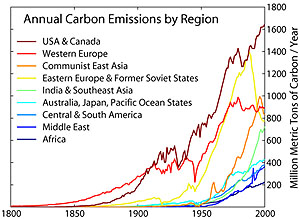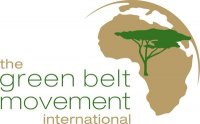To borrow a leaf from the Global voices Sub Saharan Editor's post on cyber-activism in the aftermath of the elections in Kenya; we take a look at how environmental bloggers and activists are using web 2.0 tools to bring attention to issues ranging from deforestation, conservation and global warming, and the Web 2.0 tools being used to share information, photos, videos and raise funds.
Mashups
From Ghacks, we are directed to two environmental mashups. The first is Terrapass, which helps calculate CO2 emissions from airplane travel.
TerraPass helps you calculate your carbon footprint, learn how to reduce it, and balance it out through the purchase of verified carbon offsets. Carbon offsets are a means of funding clean energy and carbon reduction projects that help to fight global warming.
The second is Floodmaps
With talk about sea level rising it is important to get a visual idea of what would happen if the sea level would rise for a certain amount of meters. Floodmaps simulates this by dynamically changing the map.
Via Googlemapsmania blog, is a pointer to another mashup called MapEcos.
MapEcos is a collaborative website designed to provide an evenhanded view of industrial environmental performance. It combines information on industrial pollution with information from facility managers about their environmental improvement efforts. In other words, MapEcos is the first public website to tell both sides of the story
Mashups are being used to hyperlocalize useful information such as recycling locations. An example of this comes from Ideum, a company that created the google maps mashup for finding recycling centers in Torrance California.
Where to Recycle in Torrance, California, helps city residents to easily find recycling centers based on the items they wish to recycle. The concept is simple: the easier it is to recycle, the more recycling will happen.
Another mashup to take a note of is Explore our planet. It uses layers over google maps to show information about the planet, such as annual CO2 emissions by region/country and tropical storms.

An advanced map interface with near realtime extensions, satellite photos and thousands of other maps illustrate hurricanes, tropical storms and earthquakes when they happen.
Blogs and Video
The wildlife direct blogs are a strong example of how to use video, audio and pictures for the environmental causes of conservation, wildlife protection and scientific research on endangered species. Richard Leakey, a pre-eminent conservationist records video clips discussing matters of climate change and whaling, then posts them on his blog, making his environmental commentary accessible to all on the internet.
The education of the younger generation about conservation and the environment is exemplified by the postings on the Wildlife Clubs of Kenya blog (also part of wildlife direct.) The mobile education unit goes out to the schools in Kenya, showing video and conversing with children about the need for conservation and appreciation of the natural environment. The blog posts video of one such visit, and continues to chronicle its work in Kenya.
The Gorilla protection blog has used the internet to reach out the world with information and updates from war torn DRC. They have also used their blog toraise funds specifically for purchasing wood fuel for displaced people in DRC. The success of their appeal is shown by a post on the 18th indicating that the fuel wood campaign they initiated a month ago surpassed its $20K goal.
Twitter
The wildlife direct group of blogs also use the popular ‘micro blogging’ tool twitter to send updates about wildlife protection and conservation efforts in Africa.
Twitter channel: Wildlife Direct
DRC: Uplifting blog post about the women in Lomami, living independently in a man's world. http://tinyurl.com/ynv7xl 12:33 PM January 22, 2008
DRC: Wanza the 2 yr old chimp recovers from flu; read more about his bar hopping, beer drinking youth here http://tinyurl.com/2bf26f 09:02 AM January 22, 2008
DRC: Elephant suffers agonizing death from “Jaw Trap”. It only takes a few dollars of support to help stop this… http://tinyurl.com/2f33gc 08:51 PM January 21, 2008
Kenya: We hardly know anything about Whale Sharks. Almost nothing. Donate a few bucks to help get the ball rolling http://tinyurl.com/28e4sr 12:35 PM January 21, 2008
Kenya: Maasai elder remembers days when murran warriors, at nighttime, would pry lions off cattle with bare hands http://tinyurl.com/38eba5 09:22 AM January 21, 2008
Cameroon: 1220 African grey parrots arrive in one day, the job now is to pull out damaged feathers. Lots of them. http://tinyurl.com/2yejb4 08:47 PM January 20, 2008
Kenya: Imagine..you're bored and you're an elephant; to help pass the time you imitate the sound of trucks. http://tinyurl.com/2k2huc 03:50 PM January 19, 2008
Global Voices Environment used its twitter channel last year to micro-blog live from the United Nations Climate change conference, and endeavors to use the twitter tool in future when attending environment related conferences and events. Please do comment if you know of other environmental tweeters so we can follow them online.
Flickr
The environment flickr group pools photos from over 960 members, creating a visual treasure trove of pictures ranging from flowers, animals, windmills and more.
Foko- Madagascar's flickr stream includes photos from rural madagascar and the organizations’ efforts in the area to plant trees and encourage a sustainable way of life.
Facebook
There are many organizations on facebook that are dedicated to the environment, clicking on the selected images below will take you a sampling of facebook groups.
The Green Belt Movement

Misc
From South Africa, Mike Stopforth who is a speaker, blogger and web entrepreneur asked on his site if someone could create a badge to show readers that he cares about the environment. The designer heeded the call and created a badge that you can download and use on your site.









21 comments
What about http://www.ecoearth.info/ . Try the search engine.
This post is very very very very useful !From FOKO FOKO we would like to thank aaaaaaaaaaall the people who are supporting us . There are those actually who go into the forests and are doing the fight for the right convictions and there a many others who want to help out and are doing everything to join the mainstream.
We learn a lot from each other and I think this is the best thing web 2.0 can give us!
bye
Great post and a lot of inspiring examples that I think some organisations here in Africa would like to explore.
Web 2.0 tools are excellent for creating environment awareness and make conceptual changes in individuals over a period of time. Interactive features like online quiz and online chats at http://IndianWildlifeClub.com are well received by our members and participation is growing.
Juliana – Great post, with lots of good resources. Social media has the capacity to spread vital information about the environment so quickly.
Web 2.0 might even be democratizing the biosphere in a way, no?
web 2.0 ‘s full potential is probably in using videos to educate and to create awareness. Unfortunately, here the world is divided into high bandwidth and low bandwidth. So democratizing the biosphere -well, it will have to wait.
Thanks everyone for the kind words…i might have to do a part 2 to this as more links are added.
Tim, i think in a way, web 2.0 IS democratizing the blogosphere, and i think it is part of the reason behind global voices online’s mission. Granted that net access is not ubiquitous in many parts of Africa, but as more people get online, we shall see more participation and varied voices, points of view and engagement in future.
I am assuming you meant blogosphere?
Susan, welcome to GV and thanks for reading…that is a very good point about using videos to educate. The low bandwidth areas are increasingly turning to cellular phones for net access; interesting stuff to follow. btw, thanks for the link indian wildlife club.
I launched my blog on the 1st Jan 2008 to raise awareness of sea level rise issues from the perspective of islanders. Developing a blog that attract readers has been a challenge but thanks to Web 2.0 tools I can integrated a number of features on my blog. I load up Yuotube videos, and also use social bookmarking to share my links on climate change and sea level rise. I invite comments and ideas as to how to make our island voice reach wider into the world.
Rolph, Seychelles
http://carma.org/ provides carbon emmissions for power plants around the world. It also provides an API for making mashups, and soon will have a number of widgets people can use on their own blogs and sites.